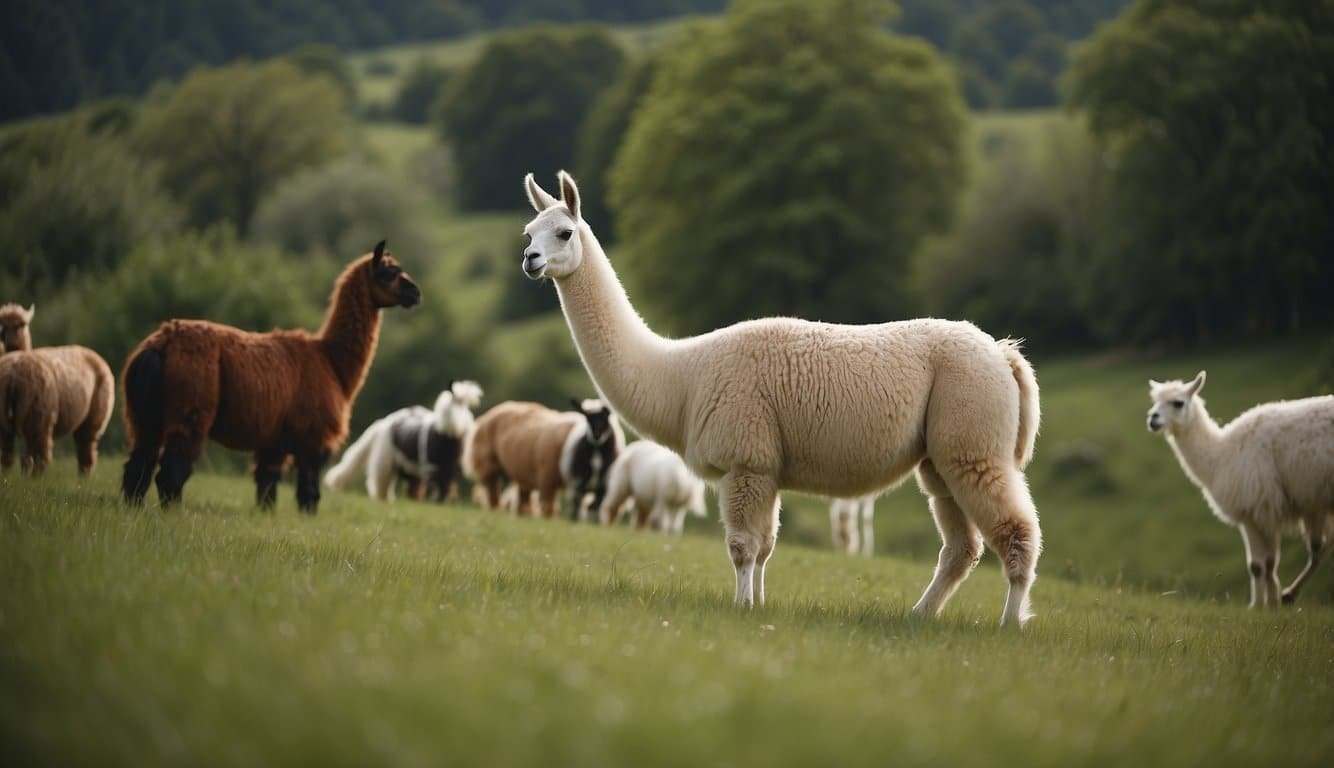Llama Basics

Llamas (Lama glama) are fascinating animals known for their quirky behavior and unique appearance. Their social nature and adaptability have made them valuable to humans for thousands of years.
Anatomy and Appearance
Llamas are large mammals with a distinctive build that includes a long neck, large ears, and a short tail. They typically weigh between 250 to 450 pounds and stand about 5.5 to 6 feet tall at the head. Llamas have a dense coat of wool, which can come in a variety of colors such as white, black, brown, and gray. Their unique features include banana-shaped ears and the ability to spit when threatened or annoyed.
- Weight: 250-450 pounds
- Height: 5.5-6 feet
- Coat: Dense wool; various colors
- Ears: Banana-shaped
Habitat and Distribution
Llamas are native to South America, specifically the Andean regions. They can thrive at high altitudes and are found in Peru, Bolivia, Ecuador, and Chile. Adapted to harsh environments, they prefer mountainous terrains but can also be found in grasslands and deserts within their range.
- Native to: South America (Andean regions)
- Habitat: Mountains, grasslands, deserts
Diet
Llamas are herbivores that primarily graze on grass. However, their diet can also include a variety of other plants, and they need a constant supply of fresh water to stay hydrated. Llamas also have a three-compartment stomach that efficiently digests roughage, allowing them to survive on limited resources.
- Food: Grass, various plants
- Water: Essential for hydration
- Stomach: Three-compartment, efficient digestion
Behavior and Lifestyle

Llamas are fascinating creatures with complex behaviors. They are highly social animals that thrive in community settings and communicate through a variety of sounds and body language. Within their social constructs, reproductive strategies and nurturing habits play a pivotal role.
Social Structure
Llamas are naturally herd animals and exhibit a strong social structure. Within a herd, there’s often a hierarchy that is established to maintain order and cohesion. These animals prefer the company of their kin and are known to form close bonds with other herd members. Pack animals by instinct, llamas are often used by humans in trekking and transport roles due to their ability to carry substantial loads over long distances.
Reproductive Habits
Llamas have unique reproductive habits as they are induced ovulators, meaning the act of mating triggers ovulation. The gestation period for a llama is approximately 11 months, and usually, a single offspring, known as a cria, is born. Female llamas reach sexual maturity around 12 months of age, while males mature around 3 years. Mating involves a unique vocalization from the male called an orgle, which is part of the courtship and copulation process.
Communication
Communication among llamas is multifaceted, involving an assortment of sounds and physical cues. Humming is the most common sound llamas make, which can express a range of emotions or intentions, from contentment to concern. Llamas also use spitting as a way to assert dominance, discourage competitors, or ward off threats. This behavior is more common during feeding times or within social interactions when establishing hierarchy.
Herbivores by nature, llamas predominantly feed on grasses and other vegetative matter, often consuming large amounts to sustain their size and energy requirements. Nursing lasts for about six months, after which the cria starts to eat solid food and gradually wean off the mother’s milk. The social and nurturing habits of llamas contribute significantly to their overall behavior and lifestyle, making them interesting subjects for animal behaviorists and enthusiasts alike.
Llama in Culture and Economy

Llamas have been integral to the cultural fabric and economic practices of various Andean communities, particularly in Peru and Bolivia, where they serve as pack animals, sources of wool, and more.
Domestication and Uses
The llama (Lama glama) is a domesticated camelid widely used throughout the Andes region. Originating from the central plains of North America, llamas were later domesticated in the Andean highlands of Peru nearly 5,000 years ago. They have been venerated in culture, depicted in art, and featured in celebrations and religious ceremonies. In terms of economy, llamas have historically been used as beasts of burden due to their ability to traverse rugged terrains while carrying loads up to 25% of their body weight. Beyond their role as pack animals, llamas provide a wealth of resources: their wool is harvested for clothing, their meat for sustenance, and even their dung as fuel. Furthermore, llamas sometimes serve as guard animals, protecting livestock herds from predators.
The uses of llamas are closely tied to family units within Andean societies, where raising and caring for llamas is often a communal effort. This collaboration extends into cultural benefits as the process of breeding, shearing, and utilizing llamas supports the local economy and strengthens community ties. Find out more about their role and significance.
Conservation Status
Llamas, as part of the larger camelid family, which includes guanacos, alpacas, and camels, have had varying conservation statuses depending on the species. While llamas themselves are not currently listed on the IUCN Red List and are considered to have a stable population, they play a role in supporting the conservation of closely associated species like the alpacas and guanacos.
In some regions, initiatives have emerged to protect the llama’s cultural and economic significance, ensuring that they maintain their role in Andean societies. Conservation efforts often emphasize sustainable practices and the importance of llamas for the livelihoods of local communities, along with their ecological role in the environment. Read more about their population and conservation efforts.

